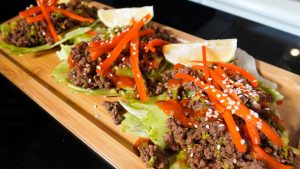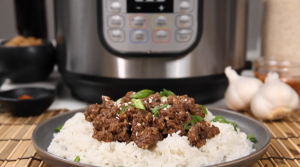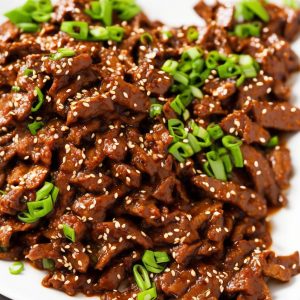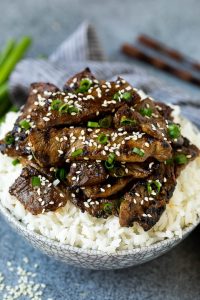Indulge in the savory flavors of Korean Cuisine with this Sous Vide Beef Bulgogi Bowls Recipe. This foolproof method ensures tender, perfectly cooked beef every time, paired with a spicy gochujang chili sauce that truly elevates this dish. Ideal for special occasions or a fancy weekend dinner.
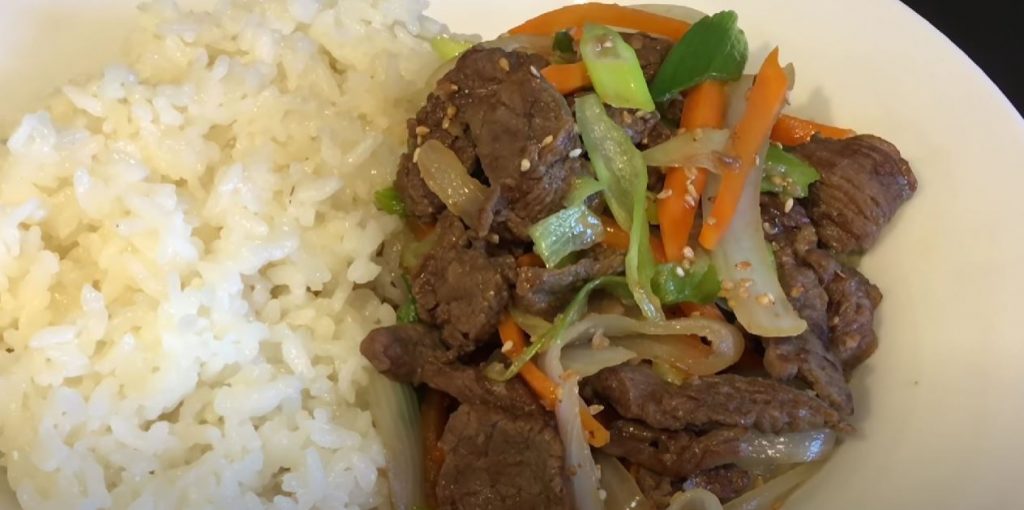
This recipe calls for a few Korean ingredients that may not be readily available in your pantry. Gochujang chili sauce is a Korean condiment, savory, sweet, and spicy in flavor. It's usually available in the Asian section of supermarkets or at Asian grocery stores. Kimchi, a fermented cabbage dish, is also a Korean ingredient and is typically found in the refrigerated section near tofu and other Asian foods.
Ingredients for Sous Vide Beef Bulgogi Bowls
Flank steak: A flavorful, lean cut of beef that's perfect for sous vide cooking.
Fresh ginger: Adds a warm, spicy flavor to the marinade.
Garlic: Infuses the beef with its pungent and spicy flavor.
Soy sauce: This adds a salty, umami flavor to the dish.
Brown sugar: It adds a touch of sweetness to balance the savory elements.
Rice wine vinegar: Adds acidity and brightness to the flavor profile.
Sesame oil: Gives a nutty, toasty flavor to the marinade.
Gochujang chili sauce: A Korean chili paste that adds a spicy, savory, and sweet flavor.
Honey: Adds a touch of natural sweetness to the bulgogi sauce.
Lime juice: Adds a fresh, citrusy tang to the sauce.
White rice: Serves as a base for the beef bulgogi, soaking up all the delicious flavors.
Kimchi: A tangy, spicy Korean side dish made from fermented cabbage.
Sesame seeds: Adds a crunchy texture and nutty flavor when sprinkled on top.
Cilantro: Used as a garnish, adding a fresh, citrusy flavor.
Thai basil: This garnish adds a unique aroma and flavor, which sets this dish apart.
One reader, Gabriele Culver says:





This sous vide beef bulgogi bowls recipe is a game-changer! The steak is incredibly tender and flavorful, and the bulgogi sauce adds a perfect balance of sweet and spicy. The combination of the beef, rice, and kimchi creates a delicious and satisfying meal. I highly recommend trying this recipe!
Culinary Skills Needed for Sous Vide Beef Bulgogi Bowls
How to sous vide the steak: The steak is placed in a zip-top bag with the marinade ingredients and then sealed using the water-displacement method to remove air. It is then cooked in a water bath at 130 degrees F for 2-3 hours using an immersion circulator.
How to make bulgogi sauce: The bulgogi sauce is made by combining gochujang chili sauce, soy sauce, honey, and lime juice. A portion of the sauce is reserved for drizzling over the bowls later, while the rest is used to sear the steak.
How to slice the beef: After sous vide cooking, the beef is removed from the bag and allowed to rest for 10 minutes. It is then sliced against the grain into thin strips for serving.
How to sear the beef: The sliced beef is quickly sautéed in a hot skillet for about a minute to develop a sear. The reserved bulgogi sauce is added to the skillet and combined with the beef for additional flavor.
How to serve the dish: The beef is served over rice with the juices from the skillet, sprinkled with sesame seeds, and accompanied by kimchi. It is garnished with cilantro and/or Thai basil, and the reserved bulgogi sauce is drizzled over the dish before serving.
How To Make Sous Vide Beef Bulgogi Bowls
This recipe for beef bulgogi bowls offers tender and flavorful sous vide cooked beef steak served over rice together with a tasty bulgogi sauce and veggies.
Serves:
Ingredients
For Steak:
- 1½lbsflank steak
- 2tspfresh ginger,grated
- 1clovegarlic,minced
- 2tbspsoy sauce
- 1tbspbrown sugar
- 1tbsprice wine vinegar
- 1tspsesame oil
- ½tspblack pepper
- 1tbspoil,for sautéing
For Bulgogi Sauce:
- ⅓cupgochujang chili sauce
- 1tbspsoy sauce
- 1tbsphoney
- 2tbsplime juice,(½ lime)
To Serve:
- white rice,cooked, for serving
- ½cupkimchi,or more, for serving
- 2tbspsesame seeds,to garnish
- handfulfresh cilantro,to garnish
- thai basil,to garnish
Instructions
-
Add steak to a large gallon-sized zip-top freezer bag.
-
Add the grated ginger, garlic, soy sauce, brown sugar, rice wine vinegar, sesame oil, and black pepper to the bag and mix well.
-
Seal the bag by using the water-displacement method to help press out all the air, by just slowly lower the bag with the steak into the water, letting the pressure of the water press the air through the top of the bag.
-
Once the top of the bag reaches the water line and all the air has been released, seal the bag. This can be done in the pot of water as it heats. (Just be careful if the water is already steaming)
-
Fill a pot with water and place your immersion circulator inside.
-
Set the temperature to 130 degrees F and let the water come up to temperature.
-
Once the water has come to the temperature, submerge the sealed bag of steak completely to ensure the food cooks evenly.
-
Cook for at least 2 hours or up to 3 hours, then remove from the water and turn off the circulator.
-
Meanwhile, prepare rice, stir together the sauce, and prepare garnishes.
-
Stir together the chili sauce, soy sauce, honey, and lime juice. and reserve about ¼ cup to drizzle on the bowls later.
-
Use the rest of the sauce when searing the steak.
-
When the steak is ready, remove it from the water and let it rest for 10 minutes.
-
Remove the beef with tongs from the bag and slice the meat against the grain into thin strips.
-
Heat 1 tablespoon of oil in a large skillet over high heat, then add the sliced beef to the pan, sautéing for 1 minute to develop a quick sear. (Don’t crowd the pan. Cook in batches if needed.)
-
Add the reserved sauce to the skillet with the beef, and combine for another 15 to 20 seconds.
-
Serve the beef over rice with juices from the skillet. Sprinkle with sesame seeds and add some kimchi on the side.
-
Garnish with cilantro and/or Thai basil.
-
Drizzle the bulgogi sauce over the dish.
Recipe Notes
- The beef can be cooked immediately for storage in the fridge for later (2 days maximum), or freeze for up to a few weeks.
- After cooking the steak sous vide, it can be cooled and refrigerated for up to 2 days before slicing and searing if desired
Nutrition
- Calories: 413.55kcal
- Fat: 21.16g
- Saturated Fat: 6.62g
- Trans Fat: 0.01g
- Monounsaturated Fat: 9.29g
- Polyunsaturated Fat: 3.09g
- Carbohydrates: 15.16g
- Fiber: 2.79g
- Sugar: 9.39g
- Protein: 38.95g
- Cholesterol: 115.67mg
- Sodium: 1110.41mg
- Calcium: 115.63mg
- Potassium: 918.72mg
- Iron: 3.88mg
- Vitamin A: 18.23µg
- Vitamin C: 7.08mg
Expert Advice for Perfecting Sous Vide Beef Bulgogi Bowls
When using the sous vide method, it's important to ensure that the bag is completely submerged in the water. This ensures even cooking and prevents any potential cold spots. If the bag floats to the top, you can use a clip or a weight to keep it fully submerged. Also, remember to give the steak a quick sear after sous vide cooking. This will give it a nice caramelized crust and enhance the flavor of the beef.
Time-Saving Tips for Preparing This Recipe
Prep ahead: Marinate the beef the night before and store it in the refrigerator. This will allow the flavors to develop and save time on the day of cooking.
Efficient slicing: Partially freeze the flank steak for easier slicing into thin strips, ensuring uniform cooking and saving time during meal preparation.
Multi-task: While the beef is cooking in the sous vide, use that time to prepare the rice, sauce, and garnishes to streamline the cooking process.
Quick sear: Sear the beef in batches to avoid overcrowding the pan, allowing for a faster and more effective sear, resulting in a delicious caramelized exterior.
Substitute Ingredients For Sous Vide Beef Bulgogi Bowls Recipe
flank steak - Substitute with skirt steak: Skirt steak has a similar texture and flavor profile to flank steak, making it a suitable substitute for this recipe.
gochujang chili sauce - Substitute with sriracha mixed with miso paste: This combination can provide a similar spicy and savory flavor profile to gochujang chili sauce.
Plating Ideas for Sous Vide Beef Bulgogi Bowls
- Elevate the plating: Carefully arrange the sliced beef in a visually appealing manner on the bed of rice, ensuring each piece is showcased beautifully.
- Incorporate vibrant colors: Introduce pops of color by garnishing the dish with vibrant kimchi, fresh cilantro, and Thai basil to create a visually stunning presentation.
- Balance the elements: Ensure a harmonious balance of flavors and textures by layering the beef, rice, and garnishes in a way that is visually appealing and appetizing.
- Highlight the sauce: Drizzle the reserved bulgogi sauce over the dish in an artful manner, creating an enticing visual element that also enhances the overall flavor profile.
- Emphasize precision: Pay attention to the placement of each component, ensuring that the dish is meticulously presented with attention to detail and precision.
Essential Equipment for Making Sous Vide Beef Bulgogi Bowls
- Sous vide machine: A device used to precisely control the temperature of a water bath for cooking food in vacuum-sealed bags.
- Gallon-sized zip-top freezer bag: A large, resealable plastic bag used for marinating and cooking food.
- Immersion circulator: A tool that attaches to a pot or container of water to maintain a consistent temperature for sous vide cooking.
- Large skillet: A wide, flat-bottomed pan with low sides, used for searing and sautéing food.
- Tongs: A utensil with two arms and a pivot used for gripping and lifting items.
- Mixing bowl: A deep bowl used for combining ingredients.
- Spatula: A flat, flexible tool used for flipping and turning food in a pan.
- Knife: A sharp tool used for slicing and cutting ingredients.
- Cutting board: A flat surface used for cutting and preparing food.
- Measuring spoons: Utensils used to measure small amounts of ingredients accurately.
- Measuring cup: A container used to measure liquid or dry ingredients.
- Skewers: Long, narrow rods used for holding and grilling food items.
- Pot: A deep, round container used for cooking food on a stovetop.
Storage and Freezing Guidelines for Sous Vide Beef Bulgogi Bowls
- Let the beef bulgogi cool completely before storing or freezing.
- Store leftover beef bulgogi in an airtight container in the refrigerator for up to 3-4 days.
- To freeze, place the cooled beef bulgogi in a freezer-safe container or resealable plastic bag, removing as much air as possible to prevent freezer burn.
- Label the container or bag with the date and contents for easy identification.
- Frozen beef bulgogi can be stored for up to 2-3 months.
- To reheat refrigerated beef bulgogi:
- Place the desired portion in a microwave-safe dish and cover loosely with a damp paper towel to prevent drying out.
- Microwave on high for 1-2 minutes, or until heated through, stirring halfway through the reheating process.
- To reheat frozen beef bulgogi:
- Thaw the frozen beef bulgogi in the refrigerator overnight or use the defrost setting on your microwave.
- Once thawed, follow the reheating instructions for refrigerated beef bulgogi.
- Store leftover rice separately in an airtight container in the refrigerator for up to 4-5 days or in the freezer for up to 1 month.
- Reheat rice in the microwave with a damp paper towel covering the dish to prevent drying out.
- Store any leftover kimchi in an airtight container in the refrigerator for up to 1 week.
- Note that the flavor of kimchi will intensify over time.
How To Reheat Leftover Sous Vide Beef Bulgogi Bowls
- Reheat the beef in a skillet over medium heat until warmed through, stirring occasionally to prevent burning. Add a splash of water or beef broth to help keep the meat moist and prevent it from drying out.
- If you have leftover rice, reheat it in the microwave with a damp paper towel covering the bowl to prevent it from drying out. Alternatively, you can reheat the rice in a steamer basket over boiling water for a few minutes until heated through.
- For a quick and easy reheat, place the leftover beef bulgogi and rice in a microwave-safe container, cover with a damp paper towel, and microwave in 30-second intervals until heated through, stirring in between intervals to ensure even heating.
- If you have a sous vide machine, you can reheat the beef using the sous vide method. Place the beef in a vacuum-sealed bag or a resealable plastic bag, remove as much air as possible, and cook in a water bath set to 130°F (54°C) for about 30 minutes, or until the beef is heated through.
- For a crispy texture, reheat the beef in a preheated oven at 400°F (200°C) for 5-10 minutes, or until heated through and slightly crispy on the edges. This method works best if you have a small amount of leftover beef.
- If you have leftover kimchi and bulgogi sauce, reheat them separately in a small saucepan over low heat until warmed through. This will help maintain their flavor and texture.
- To reheat the entire beef bulgogi bowl, place all the components (beef, rice, kimchi, and sauce) in a microwave-safe container, cover with a damp paper towel, and microwave in 30-second intervals until heated through, stirring in between intervals to ensure even heating. Garnish with fresh cilantro and Thai basil before serving.
Interesting Trivia About Sous Vide Beef Bulgogi Bowls
Bulgogi is a classic Korean dish that is traditionally made with thinly sliced beef marinated in a flavorful sauce. It is a popular dish in Korean cuisine and is often served with rice and a variety of side dishes.
Budget-Friendly or Splurge: Cost Analysis of Making Sous Vide Beef Bulgogi Bowls at Home
The cost-effectiveness of this sous vide beef bulgogi bowls recipe largely depends on the availability and cost of ingredients in your area. While flank steak and gochujang chili sauce may be pricier, the dish's overall cost can be balanced by using economical options for rice, kimchi, and garnishes. Considering the flavor, quality, and portion size, this recipe earns a solid 8/10. The approximate cost for a household of 4 people may range from $25 to $35, making it a reasonable option for a special meal or gathering.
Is This Korean-Inspired Beef Bowl Healthy or Not?
The sous vide beef bulgogi bowls recipe is a relatively healthy dish with a balance of protein, carbohydrates, and vegetables. Here are some aspects that make it a nutritious choice:
- Flank steak is a lean cut of beef, providing high-quality protein without excessive saturated fat.
- The marinade ingredients, such as ginger, garlic, and soy sauce, offer flavor without relying heavily on added sugars or unhealthy fats.
- The inclusion of kimchi provides beneficial probiotics and adds a serving of vegetables to the dish.
- Garnishes like fresh cilantro and Thai basil contribute additional vitamins and minerals.
However, there are a few areas where the recipe could be improved to make it even healthier:
- The bulgogi sauce contains gochujang chili sauce, which can be high in sodium. Opting for a low-sodium variety or reducing the amount used could help control salt intake.
- While the recipe includes kimchi, incorporating more diverse vegetables, such as sautéed spinach, carrots, or bell peppers, would increase the overall nutrient density of the dish.
To further enhance the nutritional value of the sous vide beef bulgogi bowls, consider the following suggestions:
- Swap white rice for brown rice or quinoa to increase the fiber content and provide more complex carbohydrates.
- Add a side of steamed or stir-fried vegetables to boost the vitamin and mineral content of the meal.
- Experiment with using a lower-sodium soy sauce or coconut aminos in the marinade and bulgogi sauce to reduce the overall sodium content.
- Include a source of healthy fats, such as sliced avocado or a sprinkle of chopped nuts, to promote satiety and support nutrient absorption.
Our Editor's Opinion on Sous Vide Beef Bulgogi Bowls
The sous vide beef bulgogi bowls recipe is a delightful fusion of flavors and textures. The use of sous vide cooking ensures a tender and succulent steak, while the bold and spicy bulgogi sauce adds a punch of flavor. The dish is beautifully balanced with the addition of fragrant rice, tangy kimchi, and aromatic herbs. The recipe's clear instructions make it accessible for home cooks, and the final presentation is sure to impress. Overall, this dish offers a harmonious blend of Korean-inspired elements and modern cooking techniques, resulting in a truly satisfying culinary experience.
Enhance Your Sous Vide Beef Bulgogi Bowls Recipe with These Unique Side Dishes:
Similar Recipes to Try If You Enjoy Sous Vide Beef Bulgogi Bowls
Ideal Starters and Desserts to Serve With Sous Vide Beef Bulgogi Bowls
Why trust this Sous Vide Beef Bulgogi Bowls Recipe:
This recipe offers a tantalizing fusion of flavors, combining succulent flank steak with a harmonious blend of soy sauce, brown sugar, and rice wine vinegar. The use of sous vide ensures precise cooking, resulting in tender, juicy beef that's bursting with rich, savory notes. The addition of gochujang chili sauce and kimchi infuses the dish with a delightful hint of heat and tang, while the aromatic ginger and garlic elevate the overall sensory experience. With meticulous attention to detail and a medley of vibrant garnishes, this recipe promises a culinary journey that's both authentic and unforgettable.
Was this page helpful?
Have your own special recipe to share? Submit Your Recipe Today!







